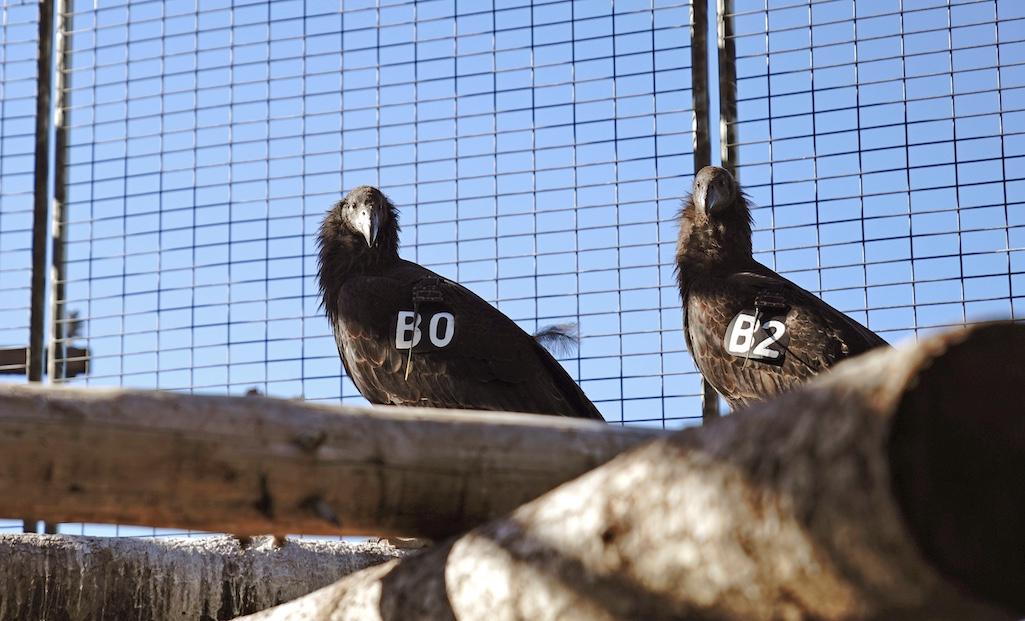
Condors B0 (female) and B2 (female), studbook designations 1140 and 1151, will soon be released into Yurok ancestral territory/Yurok Tribe
Three more California condors could be flying over Redwood National and State Parks late this week as part of a partnership between the Yurok Tribe and the National Park Service.
All three birds are healthy and behaving in a way that indicates they are ready for the wild, a release from the tribe said. The condors, known as prey-go-neesh in the tribe's language, are set to be released together. The timing of the release is contingent upon multiple factors, the biggest being weather. There must be at least a few sunny days in a row to give the birds good visibility and flight conditions when they depart the condor release and management facility.
Additionally, previously released prey-go-neesh must be present at the management facility before the release procedure is initiated. The presence of additional prey-go-neesh will ensure the new birds are as calm as possible during their first steps into the natural world. An announcement will be made when the release date is finalized. The release can be viewed live here: https://www.yuroktribe.org/yurok-condor-live-feed
“We couldn’t be more excited to release three more condors,” said Yurok Wildlife Department Director Tiana Williams-Claussen. “I would like to thank the Los Angeles Zoo as well as all of our partners, funders, and donors for supporting the reintroduction of prey-go-neesh. Soon, 11 prey-go-neesh will soar over our ancestral homeland.”
On October 9, the Northern California Condor Restoration Program, run by the tribe and the national park, received the three young condors from the Los Angeles Zoo. The newcomers are two females and one male, including 1140, wing tag B0 (female); 1148, wing tag B1(male); and 1151, wing tag B2 (female). Hatched and reared at the Los Angeles Zoo, the three prey-go-neesh are approximately 18 months old. While in the care of the zoo, the birds were vaccinated for Highly Pathogenic Avian Influenza (HPAI). They will be the first condors vaccinated for HPAI to be released into the wild.
Condors are extremely social creatures. Upon release, NCCRP biologists expect the eight free-flying birds to assist the new group in getting acclimated to a new environment. As the new condors have waited in the release and management facility, acclimating to their new home, they have been regularly visited by free-flying birds, laying the groundwork for their integration into the population.
Last year, the NCCRP released the first eight condors to fly over far Northern California in more than a century. Overall, the birds are faring very well in their new environment. NCCRP biologists and technicians regularly observe the birds exhibiting positive behaviors, such as feeding, soaring, and resting in safe roosts. They have explored much of Yurok ancestral territory in Humboldt and Del Norte counties, including trips as far south as Hyampom and as far north as the Notchko area on the Yurok Reservation. To date, their furthest trip from the NCCRP’s condor release and management facility was 52 miles.
While the NCCRP’s condor biologists are satisfied with the condors’ progress toward becoming self-sufficient, there has been one major setback.
Last month, Yurok condor A6 (Me-new-kwek’, "I am bashful or shy"), along with several other condors in the new population, consumed part of a poacher-killed elk within Bald Hills in Redwood National Park and the carrion was most likely tainted with lead. Five out of eight birds were found to have the toxin in their blood. The NCCRP believes the lead came from the illegally killed elk because of the timing, on-the-ground observations, and other strong evidence.
Of the five birds, Me-new-kwek’, wing tag A6, was the only one whose lead level came back higher than the identified treatment threshold, warranting immediate medical intervention for lead poisoning, the leading cause of death among condors. Thankfully, NCCRP and Sequoia Park Zoo staff were able to successfully treat Me-new-kwek’. He is doing well and currently serving as a mentor for the newly arrived birds. It is planned for him to be re-released with the new cohort when they are released.
Yurok Connection to the Condor
The restoration of this sacred species is an expression of the Yurok Tribe’s cultural imperative to maintain balance in the world. It is also part of a larger effort to rewild the temperate rainforest ecosystem in Yurok ancestral territory on the far Northern California coast. In addition to the reintroduction of the critically endangered condor, the tribe is currently restoring fish and wildlife habitat on significant segments of the Klamath River, Trinity River, and Prairie Creek as well as other Klamath tributaries. The tribe is also closely involved in the ongoing removal of the four Klamath dams, which represents the largest salmon habitat restoration project in U.S. history. The removal of the dams will also benefit many other fish and wildlife species, including condors.
The Yurok Tribe initiated the condor reintroduction project in 2008, with funding support from the Bureau of Indian Affairs, the U.S. Fish and Wildlife Service, and Redwood National Park, as well as the Administration for Native Americans, Pacific Gas and Electric Company, Global Conservation Fund, the National Park Foundation, and many more corporate, agency, and private supporters and citizens. The Yurok Wildlife Department completed an immense amount of work to prepare for the reintroduction of this imperiled species.



Add comment